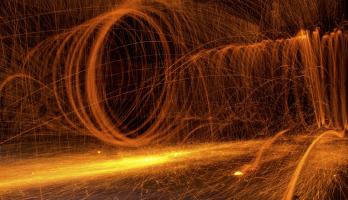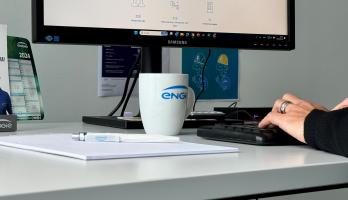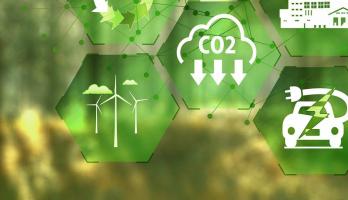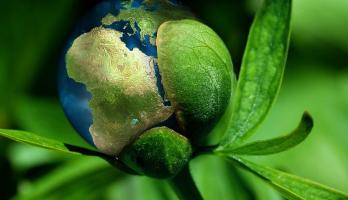
Heat recovery: efficient towards climate neutrality
A CO2 -neutral and sustainable heat supply is indispensable for the successful management of the energy transition. Sustainable paths to climate neutrality are paved by electrification and the use of efficient cooling and heating generators, which contribute significantly to the reduction of greenhouse gases and thus prevent further warming of the climate. Germany as an industrial location opens up enormous potential for this. After all, heat currently accounts for more than 50 percent of Germany's total final energy consumption. The necessary direction for more sustainability is therefore clear - but what remains on the road to climate neutrality are the large amounts of waste heat that are generated in the production of cooling and mostly go unused into the ambient air.
Heat recovery: supply solution with added value
But how can this waste heat potential be tapped? An efficient and thus sustainable strategy for achieving climate neutrality is the interweaving of cooling and heating. The ENGIE Refrigeration team ensures this through the principle of heat recovery, also known as green heat recovery. The technology is used, for example, in the air-cooled and water-cooled QUANTUM series and makes the waste heat from the cooling process usable for heating. This saves users investment costs for additional heat generation systems and at the same time increases the overall efficiency of their chiller. But it is not only the operators themselves who benefit from heat recovery: if there is no acute demand for heat among those responsible, there is also the option of passing on the waste heat to other companies or to neighbourhoods and communities. This results in holistic supply solutions that significantly advance all parties involved, both economically and ecologically.
Two energy producers, different requirements
In order to realise corresponding concepts, it is first necessary to have a precise understanding of which properties distinguish the QUANTUM chiller with heat recovery from a conventional heat pump. This is because the energy generators must be clearly distinguished from each other: In a heat pump, the heat load of the consumer:inside determines the thermal output and the operation of the compressors. The machine is therefore heat-controlled. In the case of a refrigerating machine with heat recovery, on the other hand, it is only the demand that the operator places on the refrigerating capacity that counts. In this case, the machine is cold-led, but unlike a pure refrigeration machine, it makes full use of the energy absorbed from the refrigerant and the electrical energy of the compressors in the form of heat. This is achieved, for example, by transferring it to a hot water network. The higher the cooling capacity, the greater the proportion of waste heat that is available for subsequent heating processes.
Perspectives for year-round security of supply
The principle of heat recovery is thus clear - but the path to consistently efficient use of waste heat and thus to climate neutrality is not free of obstacles. In many industries, the demand for cooling is inconsistent throughout the year. In the winter months, users often do not need cooling, which in turn means that chillers with heat recovery cannot provide heat. Because: without cold supply, no release of waste heat. A technical challenge for which ENGIE Refrigeration offers solutions. For example, our experts are currently working on an application to compensate for the inverse development of the cooling demand over the course of the year using a geothermal field. This is used as a regenerative heat source in winter, which is achieved by extracting heat from the ground. QUANTUM brings this to a higher temperature and thus makes it usable for heating. In order to prevent the ground from cooling down too much, QUANTUM feeds the waste heat from the cooling process back into the geothermal field in summer. This ensures the supply of cooling and heating throughout the year.
Valuable energy source for various industries
This means that there are realistic possibilities for the efficient design of waste heat utilisation and for achieving climate neutrality, which are relevant and interesting for various industries. But especially in applications and uses where there is a stable cooling demand throughout the year, the QUANTUM chiller with heat recovery is the ideal choice for reusing waste heat. This includes, for example, data centres, the chemical and pharmaceutical sectors and process cooling in industry. Regardless of the application, the following applies: the more users with similar cooling requirements make use of the system, the higher the yield and thus the more reliable the heat generation. The QUANTUM chiller with optional heat recovery covers temperatures between three degrees Celsius and 57 degrees Celsius. Although diversification in the supply of cooling and heat certainly has its advantages, the system is not dependent on a certain number of consumers. Alternatively, it is possible to install hydraulic decoupling on the heat side or to pass on the surplus cold and heat to district cooling and heating networks.
Paving the way to climate neutrality
Heat recovery is therefore worthwhile from both an ecological and an economic perspective - ideally even for several players at the same time. ENGIE Refrigeration supports operators with a water-cooled or an air-cooled solution, depending on their needs, in the optimal reuse of waste heat from the refrigeration process and thus in achieving climate neutrality. Worldwide, we are currently the only company on the market to offer the QUANTUM Air, an air-cooled and oil-free chiller in combination with optional heat recovery. In this way, we show a variety of paths on the way to climate neutrality, which combine sustainability, future security and efficiency in cooling and heating.









